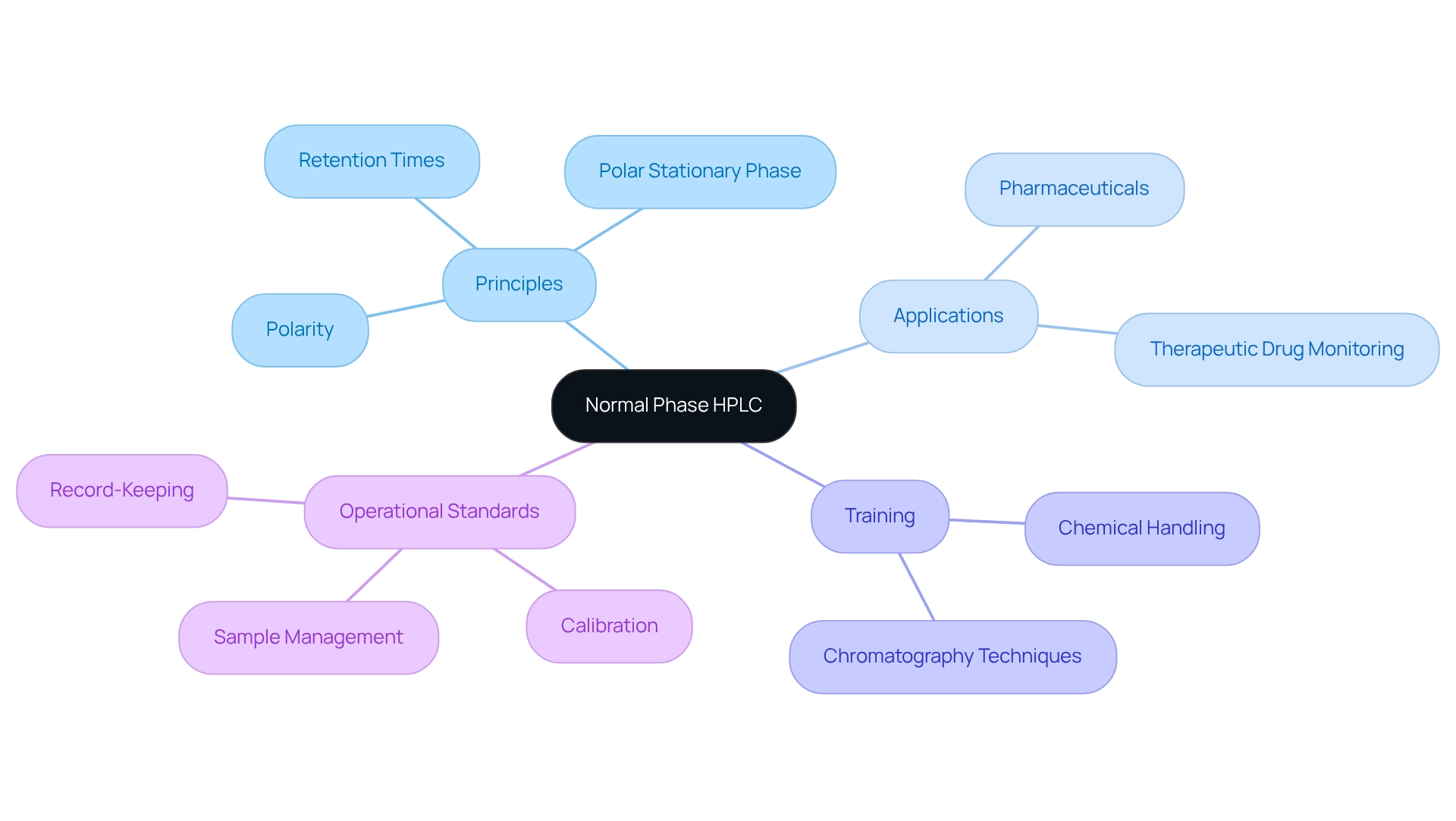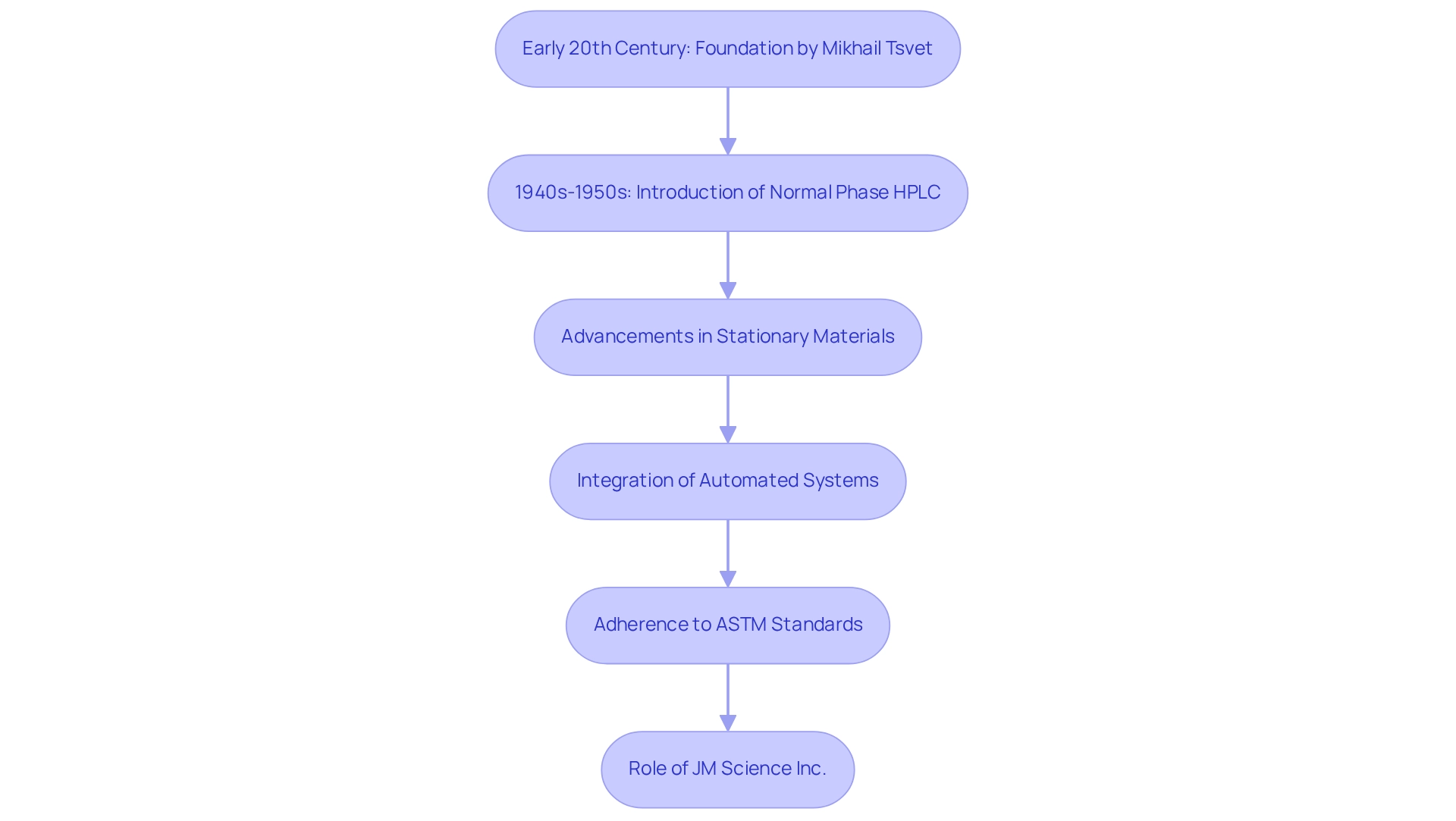Overview
This article delves into the principles and historical development of normal phase High-Performance Liquid Chromatography (HPLC), showcasing its diverse applications. It highlights the technique's critical role in analytical chemistry, particularly its effectiveness in separating polar substances. Such capabilities are essential in fields like pharmaceuticals and environmental testing. The advancements in technology and operational standards further bolster the analytical accuracy and efficiency of HPLC, underscoring its importance in modern laboratory settings.
Introduction
In the realm of analytical chemistry, Normal Phase High-Performance Liquid Chromatography (HPLC) emerges as a fundamental technique for the separation of compounds based on their polarity. This method employs a polar stationary phase coupled with a less polar mobile phase, revealing the intricate interactions among various substances. Such insights are crucial across multiple fields, including pharmaceuticals and environmental science. As the demand for precise analytical tools escalates, a comprehensive understanding of the principles, historical evolution, and diverse applications of Normal Phase HPLC is essential for professionals seeking to harness its full potential in both research and clinical settings. Furthermore, ongoing advancements in technology and methodology underscore its significance, ensuring that this chromatographic technique remains at the forefront of analytical practices.
Define Normal Phase HPLC: Principles and Significance
Normal phase HPLC is a crucial chromatographic method that separates substances according to their polarity. By employing a polar stationary phase, typically silica, in conjunction with a less polar mobile phase such as hexane or chloroform, this technique capitalizes on the differing interactions between substances and the stationary phase. Polar substances exhibit stronger interactions, resulting in longer retention times compared to their non-polar counterparts.
This technique is of paramount importance in analytical chemistry, particularly for its ability to effectively separate complex mixtures. Its applications extend across various fields, notably in pharmaceuticals, where it is utilized for therapeutic drug monitoring across multiple drug classes. The ability to accurately distinguish substances is critical, especially concerning patient confidentiality and the precise reporting of results. Standard liquid chromatography plays a vital role in these aspects by ensuring reliable separation of substances, thereby supporting accurate diagnostics and treatment decisions.
Recent findings highlight the necessity for regular training and orientation for laboratory personnel on chemical handling and chromatography techniques to maintain safety and efficiency standards. This training is particularly pertinent for normal phase HPLC, as it necessitates specific operational knowledge to ensure optimal performance. Additionally, understanding delay time—defined as the duration for non-interacting substances to travel from injection to detection—is crucial for improving chromatographic separations. This concept is underscored in the case study titled "Understanding Delay Time in Chromatographic Separation," which emphasizes the importance of this knowledge in differentiating compounds based on their interactions within the chromatographic system, thereby enhancing analytical outcomes.
As we approach 2025, the relevance of standard chromatography continues to grow, driven by advancements in analytical techniques and the increasing demand for precise measurement instruments in laboratories. The role of the polar stationary phase in chromatography is pivotal, as it directly affects the efficiency of separation and the accuracy of results, reinforcing the technique's importance in both research and clinical environments. Consistent calibration of instruments, , and meticulous record-keeping are essential for maintaining accuracy, as highlighted by Sujatha Mahadevarao Premnath, further emphasizing the necessity of stringent operational standards in the utilization of traditional chromatography.

Trace the History and Development of Normal Phase HPLC
Standard phase liquid chromatography emerged in the early 20th century as one of the foundational methods for substance separation. The groundbreaking work of Russian botanist Mikhail Tsvet in the early 1900s laid the groundwork for chromatography, establishing principles that would influence future developments. Notably, the introduction of normal phase HPLC in the 1940s and 1950s marked a significant enhancement in the separation process, paving the way for more efficient analytical techniques.
Over the decades, advancements in stationary materials and instrumentation have dramatically improved the efficiency and versatility of normal phase HPLC. These innovations have solidified its role as an essential technique in laboratories for separating polar compounds and isomers. The integration of automated systems and mass spectrometry has further propelled the adoption of standard chromatography, enhancing analytical capabilities and operational effectiveness.
Case studies underscore the impact of automation on the uptake of normal phase HPLC, illustrating how these technological advancements make such solutions increasingly attractive to users. The historical evolution of normal phase HPLC is punctuated by significant milestones, including adherence to international testing standards such as ASTM G99 and ASTM G133. These standards reflect a steadfast commitment to .
JM Science Inc. plays a vital role in this landscape, offering high-quality liquid chromatography columns and accessories, including Shodex, CapcellPak, and Reprosil columns, designed to meet the evolving demands of modern laboratories.

Examine Key Characteristics and Operational Principles of Normal Phase HPLC
The technique of stands out due to its utilization of a polar stationary phase combined with a non-polar mobile phase, facilitating the effective separation of polar substances. The core operational principle hinges on the differential adsorption of analytes to the stationary phase; polar substances experience prolonged retention due to stronger interactions, whereas non-polar substances elute more swiftly. This methodology proves particularly advantageous for normal phase HPLC, allowing for the separation of compounds that exhibit poor solubility in aqueous solvents, rendering it ideal for the analysis of lipophilic substances and positional isomers. Additionally, conventional liquid chromatography is capable of achieving high resolution and selectivity, both of which are crucial for ensuring precise analytical outcomes.
Explore Applications of Normal Phase HPLC in Various Fields
is an essential method utilized across multiple fields, especially in pharmaceuticals, environmental testing, and food safety. In the pharmaceutical sector, it is pivotal for the separation and analysis of active pharmaceutical ingredients (APIs) and their impurities, ensuring product quality and safety. Recent advancements in HPLC technology have significantly enhanced its efficacy, facilitating the effective separation of complex mixtures, including polar lipids like phospholipids and glycolipids, which are critical in drug formulation. Notably, a novel high-performance liquid chromatographic system has been developed that allows for the effective separation of various polar lipids, as highlighted by Tzortzis Nomikos in the Journal of Liquid Chromatography & Related Technologies.
Environmental scientists leverage standard chromatographic techniques to identify and quantify pollutants in water and soil samples, greatly supporting environmental monitoring initiatives. This application is increasingly crucial as regulatory bodies stress the necessity for stringent environmental assessments. Statistics reveal that high-performance liquid chromatography plays a vital role in identifying and quantifying drugs and their metabolites in forensic analyses, underscoring its significance in combating drug abuse and aiding criminal investigations. Nonetheless, the high costs associated with chromatography columns and systems present a substantial barrier to market acceptance, particularly for smaller laboratories in developing regions facing financial constraints.
In the food safety domain, standard chromatography is employed to analyze fatty acids and other lipophilic substances, ensuring compliance with health regulations. The versatility of this technique not only helps maintain safety standards but also fosters research into the nutritional aspects of food products. As the demand for high-quality analytical methods continues to escalate, the use of normal phase HPLC remains an invaluable tool in both research and industrial applications, propelling advancements in pharmaceuticals and environmental science alike.
Conclusion
The exploration of Normal Phase High-Performance Liquid Chromatography (HPLC) underscores its vital role in the separation of compounds based on polarity, illustrating its foundational principles and historical significance. Utilizing a polar stationary phase in conjunction with a less polar mobile phase, this technique adeptly differentiates between a variety of substances, proving indispensable in sectors such as pharmaceuticals, environmental analysis, and food safety. The accurate separation of complex mixtures is paramount for ensuring product quality, safety, and compliance with regulatory standards.
The historical evolution of Normal Phase HPLC represents a remarkable journey of innovation, commencing with Mikhail Tsvet's groundbreaking contributions and advancing through technological enhancements. These developments have not only bolstered the efficiency of Normal Phase HPLC but have also broadened its versatility and application range. The integration of automated systems and mass spectrometry has further accelerated its adoption, establishing it as an essential tool in contemporary laboratories.
The fundamental operational principles of Normal Phase HPLC, defined by the differential adsorption of analytes, guarantee high resolution and selectivity in analytical outcomes. Its adaptability to diverse analytical requirements, especially in the separation of polar compounds and isomers, highlights its significance in both research and clinical environments. As the demand for precise measurement instruments continues to escalate, Normal Phase HPLC emerges as a pivotal technique, with ongoing advancements poised to enhance its capabilities further. Embracing this technique not only fosters scientific progress but also reinforces a commitment to quality and precision in analytical practices across various industries.




